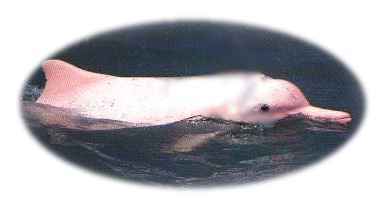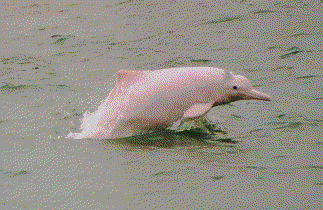Amazon River Dolphin
Inia geoffrensis



 |
|



 |
|
Varies between pink and gray. Dependent on age, sunlight, water clarity, temperature, excitement, or a combination of these factors. They are born grey, and become pinker with age. Similarly, individuals found in darker water (where the sunlight cannot penetrate as well) are pinker than those in clear water (where they develop more pigmentation, or a suntan). When excited, they flush to a bright pink color temporarily. This is most visible ventrally on their pectoral flippers and tail, and on their belly. In cold water and at death, pinkness is lost.
All dolphins have cone-shaped teeth that are used to grasp fish in their jaws. These animals are unique among dolphins, because they also have molar-like teeth and can chew their prey. Another unique characteristic are the small hairs on their rostrum (or snout) which remain throughout their life. These hairs might be used as a tactile (sense of touch) device when searching for crustaceans in the mud of the river bottom. No other species of dolphin has any hair on its body as an adult.
They are far more solitary than many oceanic species. While they are social mammals, they are generally sighted individually or in pairs (most likely mother-calf pairs, based on the size differences). Group sightings appear to be related to mating/courtship, or feeding.
The number of left in the wild has not been determined. It is thought that the population is in good condition, but highly vulnerable because of the destruction of their rainforest environment. The major threats to their survival are the construction of large hydroelectric dams along the rivers, and pollution and deforestation. The fishing industry is not a threat currently, but it is expanding rapidly, and may become a threat.
Some protective legislation exists in the seven South American countries where they are found, but these laws are very difficult to enforce. More legislation (and the means to enforce it) is necessary. Rivers ignore country boundaries and so cooperative efforts between the countries involved is crutial to their protection. Without protection, their survival is seriously threatened.
http://zoo.pgh.pa.us/wildlife/amazon_dolphin.html, All rights reserved.
http://www.geobop.com/mammals/Cetacea/Platanistidae/, All rights reserved.

[Dolphin Tales] [Stories] [Questions] [Dolphin Info] [Dolphin FAQ] [Dolphin Species] [Cetacean Glossary] [WebRings] [Graphics] [Send/Receive Postcards] [JOIN Our Webring] [Links] [Quotes] [Bookstore] [Awards and Memberships] [What's New?] [Associates] [Suggestion Box] [Sign My Guestbook] [View My Guestbook]
The maintainer of these pages is not responsible for the content of the banner above.
This page hosted by  Get your own Free Home Page
Get your own Free Home Page